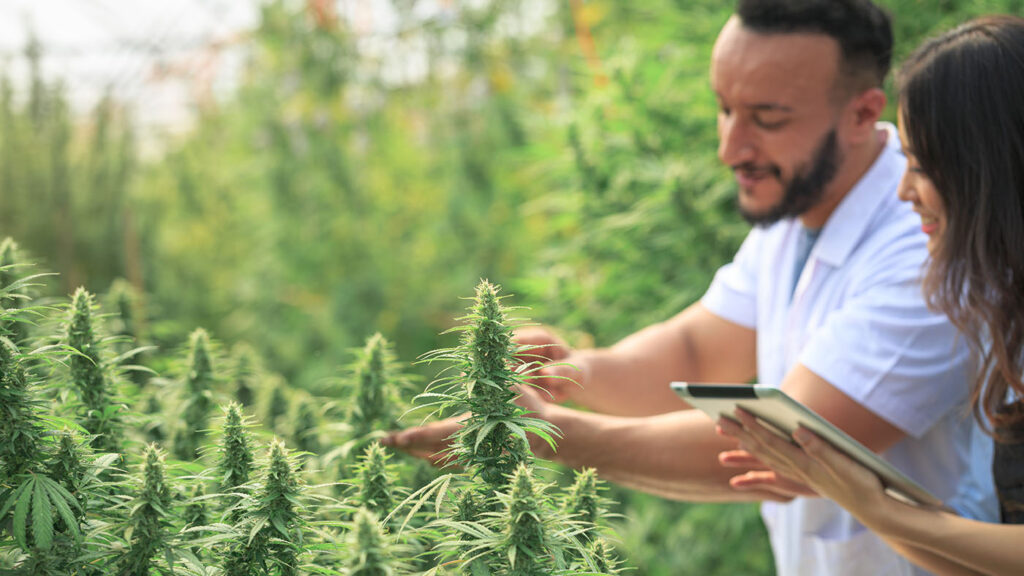Estimated reading time: 6 minutes
Table of contents
- Lack of Planning and Research
- Improper Watering Practices
- Poor Pest Management
- Inadequate Soil Preparation
- Overcrowding Plants
- Poor Genetic Selection
- Planting Too Many Strains
- Inconsistent Nutrient Management
- Inconsistent Environmental Controls
- Using Untested Growing Mediums For Your Cannabis Grow
- Final Thoughts
- Additional Resources
- Consulting Services For Cannabis, Hemp, Psilocybin, and Natural Medicine
- Testimonials and Public Relations
- Latest Articles
- Explore Our Articles
- Free Ebook – Start Your Own Legal Cannabis Business
Whether you’re an experienced cannabis cultivator or just starting, mistakes are inevitable when growing cannabis at a commercial scale. Cannabis cultivation is a dynamic and demanding industry that requires meticulous planning, precision, and expertise. Even minor errors can have significant consequences, from reduced yields to costly financial losses.
In this guide, we’ll explore 10 common mistakes among commercial cannabis growers, their impact on your operation, and practical tips to avoid them. By addressing these challenges head-on, you can enhance your growing practices and achieve consistent, high-quality results.
Lack of Planning and Research
Why It’s a Mistake
Entering the cannabis cultivation industry without thorough planning and research is like sailing without a map. The industry’s rapidly evolving regulations, technological advancements, and market dynamics make preparation non-negotiable. Many growers rush into cultivation driven by the industry’s potential profitability, only to encounter unforeseen challenges.
How to Avoid This Mistake
- Understand Regulations: Laws governing cannabis cultivation vary by region and are often complex. Familiarize yourself with local, state, and federal requirements to ensure compliance.
- Develop a Business Plan: Your business plan should include financial projections, equipment needs, operational strategies, and marketing plans.
- Research Best Practices: Utilize resources such as industry white papers, research articles, and grower forums to stay informed about advancements in cultivation techniques.
- Consult Experts: Partner with industry consultants, like Catalyst BC, for tailored advice on operational optimization and compliance.
Improper Watering Practices
The Problem
Watering cannabis plants improperly—whether through overwatering or underwatering—can compromise plant health and significantly reduce yield.
- Overwatering: Leads to waterlogged roots, oxygen deprivation, and fungal infections like root rot.
- Underwatering: Causes stress, nutrient deficiencies, and stunted growth.
Solutions
- Establish a consistent watering schedule tailored to your plant’s growth stage and environmental conditions.
- Invest in soil moisture meters to monitor water levels accurately.
- Use containers with proper drainage to prevent waterlogging.
- Adjust watering practices based on seasonal or environmental changes.
Poor Pest Management
Why It’s Critical
Pests like spider mites, aphids, and thrips are common in cannabis cultivation and can devastate crops if left unchecked. Neglecting pest management or relying solely on pesticides are common pitfalls.
Best Practices for Pest Management
- Adopt Integrated Pest Management (IPM): This approach combines prevention, monitoring, and control methods.
- Implement Sanitation Protocols: Regularly clean equipment and facilities to minimize pest infestations.
- Encourage Beneficial Insects: Predatory insects like ladybugs can naturally control pest populations.
- Monitor Regularly: Use sticky traps and visual inspections to detect infestations early.
For additional strategies, check out resources on pest management from the University of California Agriculture and Natural Resources.
Inadequate Soil Preparation
Why It’s a Problem
Healthy soil is the foundation of robust cannabis plants. Neglecting to test and amend soil can lead to nutrient imbalances, poor drainage, and stunted growth.
How to Prepare Your Soil
- Test soil for pH, nutrient levels, and organic matter content.
- Amend soil with perlite, vermiculite, or compost to improve texture and fertility.
- Rotate crops or use cover crops to maintain soil health over multiple harvest cycles.
- For a cutting-edge approach, explore vertical farming techniques for optimal soil use.
Overcrowding Plants
Why It’s Risky for Your Cannabis Grow
Plant overcrowding restricts airflow, increases humidity, and promotes the spread of diseases. It also leads to competition for resources like light and nutrients, which negatively impacts plant health.
Prevent Overcrowding
- Follow recommended spacing guidelines for your strain.
- Use pruning techniques like topping or defoliation to manage canopy density.
- Implement trellising systems to optimize space and light penetration.
Poor Genetic Selection
The Impact of Genetics
The genetics of your cannabis strains determine yield potential, pest resistance, and overall quality. Choosing the wrong genetics can result in weak plants, poor potency, and increased vulnerability to pests and diseases.
How to Choose the Right Strains For Your Cannabis Grow
- Source genetics from reputable seed banks or breeders.
- Match strains to your specific climate, grow method, and target market.
- Test multiple strains to determine which performs best in your facility.
For guidance, refer to Leafly’s comprehensive strain database.
Planting Too Many Strains
Why It’s Problematic
While diversity may seem appealing, growing too many strains can complicate cultivation. Different strains have unique growth cycles, nutrient needs, and pest resistance, making it challenging to maintain consistency.
Simplify Your Strain Selection
- Limit your grow operation to 2–3 complementary strains.
- Group plants with similar growth characteristics.
- Standardize nutrient and environmental controls across strains.
Inconsistent Nutrient Management
The Role of Nutrients On Your Cannabis Grow
Cannabis plants require a precise balance of nutrients to thrive. Overfeeding can cause nutrient burn, while underfeeding leads to deficiencies.
Tips for Nutrient Management
- Test soil and water regularly to assess nutrient levels and pH.
- Use high-quality fertilizers with a balanced mix of macronutrients (NPK) and micronutrients.
- Monitor plants for signs of nutrient stress, such as leaf discoloration or curling.
For more information on cannabis nutrition, visit Royal Queen Seeds’ guide to growing cannabis.
Inconsistent Environmental Controls
Why Consistency Is Key
Cannabis is highly sensitive to environmental factors like temperature, humidity, light, and airflow. Fluctuations can lead to stress, uneven growth, and susceptibility to pests.
Maintain Optimal Conditions
- Invest in automated climate control systems.
- Monitor environmental parameters with sensors.
- Use dehumidifiers and HVAC systems to stabilize temperature and humidity.
Using Untested Growing Mediums For Your Cannabis Grow
The Risks
Untested mediums may harbor pests, pathogens, or nutrient imbalances that can harm your plants.
How to Avoid Issues
- Purchase pre-tested and sterilized growing mediums.
- Test mediums for pH and nutrient content before use.
- Sterilize reusable containers and substrates between crops.
Final Thoughts
Cannabis cultivation offers lucrative opportunities, but it’s not without challenges. By avoiding these 10 common mistakes among commercial growers, you can protect your investment, enhance crop quality, and position your business for long-term success.
If you’re seeking expert support, Catalyst BC offers comprehensive solutions for cannabis growers, from operational optimization to genetic selection and pest management.
Additional Resources
Consulting Services For Cannabis, Hemp, Psilocybin, and Natural Medicine
- Consulting Services Overview
- Business Strategy
- Financial Planning
- Cannabis, Hemp, Psilocybin, & Natural Medicine Licensing and Applications
- Facility Design
- StartUp Support
- Genetic Development
- Business Turnaround
- Operational Optimization
- Vertical Farming
- Controlled Environmental Agriculture (CEA)
- State and Country Services Directory
- Blog
- Home
Testimonials and Public Relations
Latest Articles
- Cannabis 280E Compliance and COGS Optimization Expert StrategiesThe cannabis industry operates under a unique federal tax burden imposed by Internal Revenue Code (IRC) §280E. While state legalization has flourished, this provision, which denies deductions for ordinary business expenses of trades dealing in controlled substances, remains the single greatest threat to cannabis profitability.
- Owner’s Rep for Cannabis Dispensary Buildout: Expert Compliance & Project ManagementNavigating the highly-regulated world of a cannabis dispensary buildout requires specialized expertise beyond standard construction. The complexity of securing a final operating license, controlling costs, and preventing opening delays for a cannabis dispensary hinges on professional guidance. This is why securing an experienced Owner’s Rep for Cannabis Dispensary Buildout is a critical first step.
- The Indispensable Owner’s Rep for Cannabis Cultivation Facility Buildout: Expert Project Management to Prevent Cost OverrunsIn this high-stakes arena, the Owner’s Rep for Cannabis Cultivation Facility buildout is the crucial strategic partner. They are the expert professional who ensures the owner’s vision is translated into a successful, operational, and profitable reality.
- Cannabis Dispensary Compliance: Training, Inventory & ProfitabilityIn today’s regulated cannabis market, cannabis dispensary compliance is not optional—it is the foundation of a sustainable and profitable retail business. Every dispensary, from boutique shops to multi-state operators, must follow strict dispensary regulatory compliance standards, maintain accurate cannabis inventory management systems, and invest in ongoing cannabis dispensary training programs.
- Beyond Compliance: Implementing a Cannabis Dispensary Secret Shopper ProgramAs a cannabis retail owner, you operate in a high-stakes environment where federal prohibition meets state-regulated commerce. Your retail floor is not just a sales hub—it’s a constant target for mandatory inspection and the front line for brand differentiation. The most critical tool for navigating this complex reality is the professional, recurring Cannabis Secret Shopper program.
- Architects of the Cannabis Industry: What Defines An Expert Canna Consultant?An expert Canna Consultant is the strategic architect and operational engineer of a cannabis venture. They are specialized cannabis industry consultants who translate ambiguous legislation into profitable business processes.
Explore Our Articles
cannabis applications Cannabis Bar Cannabis Business Optmization cannabis careers Cannabis Compliance Cannabis Consumption Cannabis Consumption Bar Cannabis Inventory Management Systems Cannabis Investors cannabis jobs Cannabis Legalization cannabis licensing Cannabis Lounge cannabis marketing Cannabis Operational Procedures cannabis outreach Cannabis Regulations Cannabis Security Cannabis Software Cannabis Startup Cannabis Supply Chain Cannabis Technology Colorado controlled environment agriculture Cultivation cultivation facility Dispensary Design facility design Financial Planning HVAC HVACD Iowa Kansas Legal Update Legislation Medical Cannabis Minnesota Natural Medicine Nebraska New York Odor Control Oregon Psilocybin Psychedelics Recreational Cannabis
Free Ebook – Start Your Own Legal Cannabis Business








